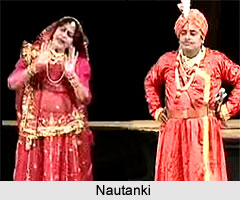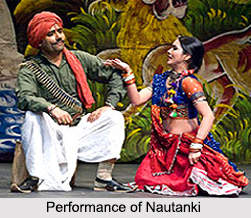 Nautanki is a popular folk theater form of the South Asia, specifically the Northern India. Prior to the inception of Bollywood, the biggest medium of entertainment was Nautanki in north Indian towns and villages. The performing arts contain rich and humorous musical compositions with entertaining storylines that hold the potential of strong influence to the north Indian states. It shapes the imagination and thought processes of the rural people, thus, being an important and popular mass medium. The content of Nautanki mostly revolves around three sections that are romantic storylines, humorous storylines and biography of the local heroes.
Nautanki is a popular folk theater form of the South Asia, specifically the Northern India. Prior to the inception of Bollywood, the biggest medium of entertainment was Nautanki in north Indian towns and villages. The performing arts contain rich and humorous musical compositions with entertaining storylines that hold the potential of strong influence to the north Indian states. It shapes the imagination and thought processes of the rural people, thus, being an important and popular mass medium. The content of Nautanki mostly revolves around three sections that are romantic storylines, humorous storylines and biography of the local heroes.
The melodies accompanying the songs and the dances have obtained from various forms akin to the mass. The themes for the dances are sometimes derived from the episodes of struggle between the benevolent and malevolent forces of nature. They also evolve from the religious epics or heroic deeds from historic traditions, such as Allah and Udal. Quite often the "Nautanki" players enact plays based on the day-to-day problems of social life, or deal patriotic themes such as the martyrdom of Bhagat Singh.
History of Nautanki
The inception of the age old performative tradition of Nautanki goes back to hundred years ago. The origin of Nautanki resides in the traditional folk performances of Rasleela of Vrinadaban and Mathura, Uttar Pradesh. References of the former art form was found in the 16th century book known as “Ain-e-Akbari†by Abul Fazl at emperor Akbar"s court. More appropriately the history emerges a clear presentation in the printing press of India during 19th Century and publications of Nautanki Operas in the form Chap-books.
Nautanki reached pinnacle of glory in the early 20th century. Numerous performing troupes known as “akharas†and “mandalis†began to emerge. The manadalis were known as “akhadas†because of the prevalent specific type of singing that demanded lots of potential power. The performances staged by these akharas or mandalis became the main entertainment source in small north Indian villages and towns.
Concept of Nautanki
The Nautanki dance usually begins around midnight and carries on till daybreak of next day. Nautanki was the only form of entertainment prevalent in India, before the advent of television and Indian movies. A characteristic of Nautanki is that it is always been an open and secular dramatic form till date. All elements of Nautanki dance, music are used with an unlimited scope for improvisation which today is explored with their relevance in contemporary themes. Nautanki has developed according to the changing needs of the large masses of people who live in the villages of India. Apart from these two places, the other places where Nautanki has its root and grew are Hathras and Kanpur.
 Theme of Nautanki
Theme of Nautanki
The presentation of story and incidents is done in a familiar suggestive idiom, to establish a contact with the audience. Music plays a very important role to discover and expose the various layers of meaning and provide a new dimension to theatrical reality in essence. The prominent musical instrument used is the nagada and it is played after each portion is over. Nagada is a single-faced kettledrum, which in fact announces a Nautanki performance in a village area. Sometimes the sarangi and harmonium are also used for generating music and the dholak also provides the additional rhythm. An important element of Nautanki is satire and also used for the same purpose. Many times the Nautanki artistes are from those families, who have been in this profession for generations. Most of them are illiterate, though a number of professional singers have also joined Nautanki mandlis.
Music of Nautanki
Nautanki is performed on stage that can be courtyards or maidens. The music used for this performance has the elements of classical as well as folk. In fact, it has a pattern of its own, which is consistent for dramas. The poetry is written in various metrical patterns and sung as per the convention and requirements of current performance. The verses used are simple, direct and it appeals towards human emotions. To avoid monotonous treatment of the verses, many new ideas are also used; like the introduction of a short verse called kada between the three stanzas.
The basic verse used can be divided into three portions such as:
1. Doha which is sung free, without a beat or musical accomplishment.
2. Choubola which forms the main stanza.
3. Daur or Chalti or Udhan, which is sung at a great speed & also becomes very slow at the end.
The overall popularity of the Nautanki artist is decided from the power of his voice, the meanings he can draw out from the written verse, and the expressions he can deliver at that moment. The language in which the Nautanki is written is Hindustani. The Braj Nautankis is mostly in verse form, whereas the Nautanki in Kanpur have Urdu poetry and plenty of straightforward prose dialogues. The Nautanki also contains certain elements of the Sanskrit theatre, both in selecting stories and in the sequence wise unravelling of the plot. The effect of the Parsi theatre is also visible in the style of enactment, particularly in case of the Kanpur school of Nautanki.
Contemporary Scenario of Nautanki
At present, it is experiencing a sort of dialectic tension. On one hand it holds an important place in the hearts of people even now whereas on the other hand, it is facing struggles to deal with mutable aspirations of its audiences in the presence of television and cinema. The performing arts have failed to attempt contemporize the script and its subject matter. The times are changing and after the mark of digitalization, people hardly take out the time to visit theatres and performance arts on a general basis. Many say that Nautanki may be losing its mass appeal in the absence of any recognition from the establishment theatre form of India. However, some artistes are still working hard to keep Nautanki alive, as it was once, the strongest mass medium in the states of Uttar Pradesh and Bihar.



















